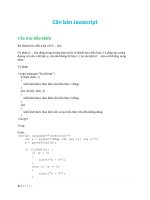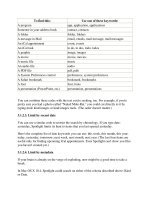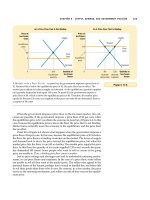Tài liệu The elements of style part 2 doc
Bạn đang xem bản rút gọn của tài liệu. Xem và tải ngay bản đầy đủ của tài liệu tại đây (320.61 KB, 15 trang )
Nonrestrictive relative clauses are parenthetic, as are similar clauses introduced by
conjunctions indicating time or place. Commas are therefore needed. A nonrestrictive
clause is one that does not serve to identify or define the antecedent noun.
The audience, which had at first been indifferent, became more and more
interested.
In 1769, when Napoleon was born, Corsica had but recently been acquired
by France.
Nether Stowey, where Coleridge wrote
The Rime of the Ancient Mariner
, is a
few miles from Bridgewater.
In these sentences, the clauses introduced by
which
,
when
, and
where
are nonrestrictive;
they do not limit or define, they merely add something. In the first example, the clause
introduced by
which
does not serve to tell which of several possible audiences is meant;
the reader presumably knows that already. The clause adds, parenthetically, a statement
supplementing that in the main clause. Each of the three sentences is a combination of
two statements that might have been made independently.
The audience was at first indifferent. Later it became more and more
interested.
Napoleon was born in 1769. At that time Corsica had but recently been
acquired by France.
Coleridge wrote
The Rime of the Ancient Mariner
at Nether Stowey. Nether
Stowey is a few miles from Bridgewater.
Restrictive clauses, by contrast, are not parenthetic and are not set off by commas. Thus,
People who live in glass houses shouldn't throw stones.
Here the clause introduced by
who
does serve to tell which people are meant; the
sentence, unlike the sentences above, cannot be split into two independent statements.
The same principle of comma use applies to participial phrases and to appositives.
People sitting in the rear couldn't hear,
(restrictive
)
16
For more material and information, please visit Tai Lieu Du Hoc at www.tailieuduhoc.org
Uncle Bert, being slightly deaf, moved forward,
(non-restrictive
)
My cousin Bob is a talented harpist,
(restrictive
)
Our oldest daughter, Mary, sings,
(nonrestrictive
)
When the main clause of a sentence is preceded by a phrase or a subordinate clause, use
a comma to set off these elements.
Partly by hard fighting, partly by diplomatic skill, they enlarged their
dominions to the east and rose to royal rank with the possession of Sicily.
4. Place a comma before a conjunction introducing an independent clause.
The early records of the city have disappeared, and the story of its first years can no
longer be reconstructed.
The situation is perilous, but there is still one chance of escape.
Two-part sentences of which the second member is introduced by as (in the sense of
"because"),
for, or, nor
, or
while
(in the sense of "and at the same time") likewise require a
comma before the conjunction.
If a dependent clause, or an introductory phrase requiring to be set off by a comma,
precedes the second independent clause, no comma is needed after the conjunction.
The situation is perilous, but if we are prepared to act promptly, there is still one chance of
escape.
When the subject is the same for both clauses and is expressed only once, a comma is
useful if the connective is
but
. When the connective is
and
, the comma should be omitted if
the relation between the two statements is close or immediate.
I have heard the arguments, but am still unconvinced.
He has had several years' experience and is thoroughly competent.
5. Do not join independent clauses with a comma.
If two or more clauses grammatically complete and not joined by a conjunction are to form
a single compound sentence, the proper mark of punctuation is a semicolon.
Mary Shelley's works are entertaining; they are full of engaging ideas.
17
For more material and information, please visit Tai Lieu Du Hoc at www.tailieuduhoc.org
It is nearly half past five; we cannot reach town before dark.
It is, of course, equally correct to write each of these as two sentences, replacing the
semicolons with periods.
Mary Shelley's works are entertaining. They are full of engaging ideas.
It is nearly half past five. We cannot reach town before dark.
If a conjunction is inserted, the proper mark is a comma. (Rule 4.)
Mary Shelley's works are entertaining, for they are full of engaging ideas.
It is nearly half past five, and we cannot reach town before dark.
A comparison of the three forms given above will show clearly the advantage of the first. It
is, at least in the examples given, better than the second form because it suggests the
close relationship between the two statements in a way that the second does not attempt,
and better than the third because it is briefer and therefore more forcible. Indeed, this
simple method of indicating relationship between statements is one of the most useful
devices of composition. The relationship, as above, is commonly one of cause and
consequence.
Note that if the second clause is preceded by an adverb, such as
accordingly, besides,
then, therefore
, or
thus
, and not by a conjunction, the semicolon is still required.
I had never been in the place before; besides, it was dark as a tomb.
An exception to the semicolon rule is worth noting here. A comma is preferable when the
clauses are very short and alike in form, or when the tone of the sentence is easy and
conversational.
Man proposes, God disposes.
The gates swung apart, the bridge fell, the portcullis was drawn up.
I hardly knew him, he was so changed.
Here today, gone tomorrow.
18
For more material and information, please visit Tai Lieu Du Hoc at www.tailieuduhoc.org
6. Do not break sentences in two.
In other words, do not use periods for commas.
I met them on a Cunard liner many years ago. Coming home from Liverpool
to New York.
She was an interesting talker. A woman who had traveled all over the world
and lived in half a dozen countries.
In both these examples, the first period should be replaced by a comma and the following
word begun with a small letter.
It is permissible to make an emphatic word or expression serve the purpose of a sentence
and to punctuate it accordingly:
Again and again he called out. No reply.
The writer must, however, be certain that the emphasis is warranted, lest a clipped
sentence seem merely a blunder in syntax or in punctuation. Generally speaking, the place
for broken sentences is in dialogue, when a character happens to speak in a clipped or
fragmentary way.
Rules 3, 4, 5, and 6 cover the most important principles that govern punctuation. They
should be so thoroughly mastered that their application becomes second nature.
7. Use a colon after an independent clause to introduce a list of particulars, an
appositive, an amplification, or an illustrative quotation.
A colon tells the reader that what follows is closely related to the preceding clause. The
colon has more effect than the comma, less power to separate than the semicolon, and
more formality than the dash. It usually follows an independent clause and should not
separate a verb from its complement or a preposition from its object. The examples in the
lefthand column, below, are wrong; they should be rewritten as in the righthand column.
Your dedicated whittler requires: a knife, a piece of wood, and a back porch.
Understanding is that penetrating quality of knowledge that grows from:
theory, practice, conviction, assertion, error, and humiliation.
19
For more material and information, please visit Tai Lieu Du Hoc at www.tailieuduhoc.org
Your dedicated whittler requires three props: a knife, a piece of wood, and a
back porch.
Understanding is that penetrating quality of knowledge that grows from
theory, practice, conviction, assertion, error, and humiliation.
Join two independent clauses with a colon if the second interprets or amplifies the first.
But even so, there was a directness and dispatch about animal burial: there
was no stopover in the undertaker's foul parlor, no wreath or spray.
A colon may introduce a quotation that supports or contributes to the preceding clause.
The squalor of the streets reminded her of a line from Oscar Wilde: "We are
all in the gutter, but some of us are looking at the stars."
The colon also has certain functions of form: to follow the salutation of a formal letter, to
separate hour from minute in a notation of time, and to separate the title of a work from its
subtitle or a Bible chapter from a verse.
Dear Mr. Montague:
departs at 10:48 P.M.
Practical Calligraphy: An Introduction to Italic Script
Nehemiah 11:7
8. Use a dash to set off an abrupt break or interruption and to announce a long
appositive or summary.
A dash is a mark of separation stronger than a comma, less formal than a colon, and more
relaxed than parentheses.
His first thought on getting out of bed — if he had any thought at all — was to
get back in again.
The rear axle began to make a noise — a grinding, chattering, teeth-gritting
rasp.
20
For more material and information, please visit Tai Lieu Du Hoc at www.tailieuduhoc.org
The increasing reluctance of the sun to rise, the extra nip in the breeze, the
patter of shed leaves dropping — all the evidences of fall drifting into winter
were clearer each day.
Use a dash only when a more common mark of punctuation seems inadequate.
Her father's suspicions proved well-
founded — it was not Edward she cared
for — it was San Francisco.
Her father's suspicions proved well-
founded. It was not Edward she cared for, it
was San Francisco.
Violence — the kind you see on
television — is not honestly violent — there
lies its harm.
Violence, the kind you see on television, is
not honestly violent. There lies its harm.
9. The number of the subject determines the number of the verb.
Words that intervene between subject and verb do not affect the number of the verb.
The bittersweet flavor of youth — its trials,
its joys, its adventures, its challenges — are
not soon forgotten.
The bittersweet flavor of youth — its trials,
its joys, its adventures, its challenges — is
not soon forgotten.
A common blunder is the use of a singular verb form in a relative clause following "one
of " or a similar expression when the relative is the subject.
One of the ablest scientists who has attacked
this problem
One of the ablest scientists who have
attacked this problem
One of those people who is never ready on
time
One of those people who are never ready on
time
Use a singular verb form after
each, either, everyone, everybody, neither, nobody,
someone
.
Everybody thinks he has a unique sense of humor.
Although both clocks strike cheerfully, neither keeps good time.
With
none
, use the singular verb when the word means "no one" or "not one."
None of us are perfect.
None of us is perfect.
A plural verb is commonly used when
none
suggests more than one thing or person.
21
For more material and information, please visit Tai Lieu Du Hoc at www.tailieuduhoc.org
None are so fallible as those who are sure they're right.
A compound subject formed of two or more nouns joined by
and
almost always requires a
plural verb.
The walrus and the carpenter were walking close at hand.
But certain compounds, often cliches, are so inseparable they are considered a unit and
so take a singular verb, as do compound subjects qualified by
each
or
every
.
The long and the short of it is
Bread and butter was all she served.
Give and take is essential to a happy household.
Every window, picture, and mirror was smashed.
A singular subject remains singular even if other nouns are connected to it by
with, as well
as, in addition to, except, together with
, and
no less than
.
His speech as well as his manner is objectionable.
A linking verb agrees with the number of its subject.
What is wanted is a few more pairs of hands.
The trouble with truth is its many varieties.
Some nouns that appear to be plural are usually construed as singular and given a
singular verb.
Politics is an art, not a science.
The Republican Headquarters is on this side of the tracks.
But
The general's quarters are across the river.
22
For more material and information, please visit Tai Lieu Du Hoc at www.tailieuduhoc.org
In these cases the writer must simply learn the idioms. The contents of a book is singular.
The contents of a jar may be either singular or plural, depending on what's in the jar — jam
or marbles.
10. Use the proper case of pronoun.
The personal pronouns, as well as the pronoun
who
, change form as they function as
subject or object.
Will Jane or he be hired, do you think?
The culprit, it turned out, was he.
We heavy eaters would rather walk than ride.
Who knocks?
Give this work to whoever looks idle.
In the last example,
whoever
is the subject
of looks idle
; the object of the preposition
to
is
the entire clause
whoever looks idle
. When
who
introduces a subordinate clause, its case
depends on its function in that clause.
Virgil Soames is the candidate whom we
think will win.
Virgil Soames is the candidate who we
think will win. [We think he will win.]
Virgil Soames is the candidate who we hope
to elect.
Virgil Soames is the candidate whom we
hope to elect. [We hope to elect him.]
A pronoun in a comparison is nominative if it is the subject of a stated or understood verb.
Sandy writes better than I. (Than I write.)
In general, avoid "understood" verbs by supplying them.
I think Horace admires Jessica more than I. I think Horace admires Jessica more than I
do.
Polly loves cake more than me. Polly loves cake more than she loves me.
The objective case is correct in the following examples.
The ranger offered Shirley and him some advice on campsites.
23
For more material and information, please visit Tai Lieu Du Hoc at www.tailieuduhoc.org
They came to meet the Baldwins and us.
Let's talk it over between us, then, you and me.
Whom should I ask?
A group of us taxpayers protested.
Us
in the last example is in apposition to taxpayers, the object of the preposition
of
. The
wording, although grammatically defensible, is rarely apt. "A group of us protested as
taxpayers" is better, if not exactly equivalent.
Use the simple personal pronoun as a subject.
Blake and myself stayed home. Blake and I stayed home.
Howard and yourself brought the lunch, I
thought.
Howard and you brought the lunch, I
thought.
The possessive case of pronouns is used to show ownership. It has two forms: the
adjectival modifier,
your
hat, and the noun form, a hat
of yours
.
The dog has buried one of your gloves and one of mine in the flower bed.
Gerunds usually require the possessive case.
Mother objected to our driving on the icy roads.
A present participle as a verbal, on the other hand, takes the objective case.
They heard him singing in the shower.
The difference between a verbal participle and a gerund is not always obvious, but note
what is really said in each of the following.
Do you mind me asking a question?
Do you mind my asking a question?
In the first sentence, the queried objection is to
me
, as opposed to other members of the
group, asking a question. In the second example, the issue is whether a question may be
asked at all.
24
For more material and information, please visit Tai Lieu Du Hoc at www.tailieuduhoc.org
11. A participial phrase at the beginning of a sentence must refer to the
grammatical subject.
Walking slowly down the road, he saw a woman accompanied by two
children.
The word
walking
refers to the subject of the sentence, not to the woman. To make it refer
to the woman, the writer must recast the sentence.
He saw a woman, accompanied by two children, walking slowly down the
road.
Participial phrases preceded by a conjunction or by a preposition, nouns in apposition,
adjectives, and adjective phrases come under the same rule if they begin the sentence.
On arriving in Chicago, his friends met him
at the station.
On arriving in Chicago, he was met at the
station by his friends.
A soldier of proved valor, they entrusted
him with the defense of the city.
A soldier of proved valor, he was entrusted
with the defense of the city.
Young and inexperienced, the task seemed
easy to me.
Young and inexperienced, I thought the task
easy.
Without a friend to counsel him, the
temptation proved irresistible.
Without a friend to counsel him, he found
the temptation irresistible.
Sentences violating Rule 11 are often ludicrous:
Being in a dilapidated condition, I was able to buy the house very cheap.
Wondering irresolutely what to do next, the clock struck twelve.
25
For more material and information, please visit Tai Lieu Du Hoc at www.tailieuduhoc.org
II
Elementary Principles of Composition
12. Choose a suitable design and hold to it.
A basic structural design underlies every kind of writing. Writers will in part follow this
design, in part deviate from it, according to their skills, their needs, and the unexpected
events that accompany the act of composition. Writing, to be effective, must follow closely
the thoughts of the writer, but not necessarily in the order in which those thoughts occur.
This calls for a scheme of procedure. In some cases, the best design is no design, as with
a love letter, which is simply an outpouring, or with a casual essay, which is a ramble. But
in most cases, planning must be a deliberate prelude to writing. The first principle of
composition, therefore, is to foresee or determine the shape of what is to come and pursue
that shape.
A sonnet is built on a fourteen-line frame, each line containing five feet. Hence, sonneteers
know exactly where they are headed, although they may not know how to get there. Most
forms of composition are less clearly defined, more flexible, but all have skeletons to which
the writer will bring the flesh and the blood. The more clearly the writer perceives the
shape, the better are the chances of success.
13. Make the paragraph the unit of composition.
The paragraph is a convenient unit; it serves all forms of literary work. As long as it holds
together, a paragraph may be of any length — a single, short sentence or a passage of
great duration.
If the subject on which you are writing is of slight extent, or if you intend to treat it briefly,
there may be no need to divide it into topics. Thus, a brief description, a brief book review,
a brief account of a single incident, a narrative merely outlining an action, the setting forth
of a single idea — any one of these is best written in a single paragraph. After the
paragraph has been written, examine it to see whether division will improve it.
Ordinarily, however, a subject requires division into topics, each of which should be dealt
with in a paragraph. The object of treating each topic in a paragraph by itself is, of course,
26
For more material and information, please visit Tai Lieu Du Hoc at www.tailieuduhoc.org
to aid the reader. The beginning of each paragraph is a signal that a new step in the
development of the subject has been reached.
As a rule, single sentences should not be written or printed as paragraphs. An exception
may be made of sentences of transition, indicating the relation between the parts of an
exposition or argument
In dialogue, each speech, even if only a single word, is usually a paragraph by itself; that is,
a new paragraph begins with each change of speaker. The application of this rule when
dialogue and narrative are combined is best learned from examples in well-edited works of
fiction. Sometimes a writer, seeking to create an effect of rapid talk or for some other
reason, will elect not to set off each speech in a separate paragraph and instead will run
speeches together. The common practice, however, and the one that serves best in most
instances, is to give each speech a paragraph of its own.
As a rule, begin each paragraph either with a sentence that suggests the topic or with a
sentence that helps the transition. If a paragraph forms part of a larger composition, its
relation to what precedes, or its function as a part of the whole, may need to be expressed.
This can sometimes be done by a mere word or phrase
(again, therefore, for the same
reason
) in the first sentence. Sometimes, however, it is expedient to get into the topic
slowly, by way of a sentence or two of introduction or transition.
In narration and description, the paragraph sometimes begins with a concise,
comprehensive statement serving to hold together the details that follow.
The breeze served us admirably.
The campaign opened with a series of reverses.
The next ten or twelve pages were filled with a curious set of entries.
But when this device, or any device, is too often used, it becomes a mannerism. More
commonly, the opening sentence simply indicates by its subject the direction the
paragraph is to take.
At length I thought I might return toward the stockade.
He picked up the heavy lamp from the table and began to explore.
Another flight of steps, and they emerged on the roof.
27
For more material and information, please visit Tai Lieu Du Hoc at www.tailieuduhoc.org
In animated narrative, the paragraphs are likely to be short and without any semblance of
a topic sentence, the writer rushing headlong, event following event in rapid succession.
The break between such paragraphs merely serves the purpose of a rhetorical pause,
throwing into prominence some detail of the action.
In general, remember that paragraphing calls for a good eye as well as a logical mind.
Enormous blocks of print look formidable to readers, who are often reluctant to tackle them.
Therefore, breaking long paragraphs in two, even if it is not necessary to do so for sense,
meaning, or logical development, is often a visual help. But remember, too, that firing off
many short paragraphs in quick succession can be distracting. Paragraph breaks used
only for show read like the writing of commerce or of display advertising. Moderation and a
sense of order should be the main considerations in paragraphing.
14. Use the active voice.
The active voice is usually more direct and vigorous than the passive:
I shall always remember my first visit to Boston.
This is much better than
My first visit to Boston will always be remembered by me.
The latter sentence is less direct, less bold, and less concise. If the writer tries to make it
more concise by omitting "by me,"
My first visit to Boston will always be remembered,
it becomes indefinite: is it the writer or some undisclosed person or the world at large that
will always remember this visit?
This rule does not, of course, mean that the writer should entirely discard the passive
voice, which is frequently convenient and sometimes necessary.
The dramatists of the Restoration are little esteemed today.
Modern readers have little esteem for the dramatists of the Restoration.
The first would be the preferred form in a paragraph on the dramatists of the Restoration,
the second in a paragraph on the tastes of modern readers. The need to make a particular
28
For more material and information, please visit Tai Lieu Du Hoc at www.tailieuduhoc.org
word the subject of the sentence will often, as in these examples, determine which voice is
to be used.
The habitual use of the active voice, however, makes for forcible writing. This is true not
only in narrative concerned principally with action but in writing of any kind. Many a tame
sentence of description or exposition can be made lively and emphatic by substituting a
transitive in the active voice for some such perfunctory expression as
there is
or
could be
heard
.
There were a great number of dead leaves
lying on the ground.
Dead leaves covered the ground.
At dawn the crowing of a rooster could be
heard.
The cock's crow came with dawn.
The reason he left college was that his
health became impaired.
Failing health compelled him to leave
college.
It was not long before she was very sorry
that she had said what she had.
She soon repented her words.
Note, in the examples above, that when a sentence is made stronger, it usually becomes
shorter. Thus, brevity is a by-product of vigor.
15. Put statements in positive form.
Make definite assertions. Avoid tame, colorless, hesitating, noncommittal language. Use
the word
not
as a means of denial or in antithesis, never as a means of evasion.
He was not very often on time. He usually came late.
She did not think that studying Latin was a
sensible way to use one's time.
She thought the study of Latin a waste of
time.
The Taming of the Shrew is rather weak in
spots. Shakespeare does not portray
Katharine as a very admirable character, nor
does Bianca remain long in memory as an
important character in Shakespeare's works.
The women in The Taming of the Shrew are
unattractive. Katharine is disagreeable,
Bianca insignificant.
The last example, before correction, is indefinite as well as negative. The corrected
version, consequently, is simply a guess at the writer's intention.
All three examples show the weakness inherent in the word
not
. Consciously or
unconsciously, the reader is dissatisfied with being told only what is not; the reader wishes
to be told what is. Hence, as a rule, it is better to express even a negative in positive form.
29
For more material and information, please visit Tai Lieu Du Hoc at www.tailieuduhoc.org
not honest dishonest
not important trifling
did not remember forgot
did not pay any attention to ignored
did not have much confidence in distrusted
Placing negative and positive in opposition makes for a stronger structure.
Not charity, but simple justice.
Not that I loved Caesar less, but that I loved Rome more.
Ask not what your country can do for you — ask what you can do for your
country.
Negative words other than
not
are usually strong.
Her loveliness I never knew / Until she smiled on me.
Statements qualified with unnecessary auxiliaries or conditionals sound irresolute.
If you would let us know the time of your
arrival, we would be happy to arrange your
transportation from the airport.
If you will let us know the time of your
arrival, we shall be happy to arrange your
transportation from the airport.
Applicants can make a good impression by
being neat and punctual.
Applicants will make a good impression if
they are neat and punctual.
Plath may be ranked among those modem
poets who died young.
Plath was one of those modern poets who
died young.
If your every sentence admits a doubt, your writing will lack authority. Save the auxiliaries
would, should, could, may, might
, and
can
for situations involving real uncertainty.
16. Use definite, specific, concrete language.
Prefer the specific to the general, the definite to the vague, the concrete to the abstract.
A period of unfavorable weather set in. It rained every day for a week.
He showed satisfaction as he took
possession of his well-earned reward.
He grinned as he pocketed the coin.
If those who have studied the art of writing are in accord on any one point, it is this: the
surest way to arouse and hold the readers attention is by being specific, definite, and
30
For more material and information, please visit Tai Lieu Du Hoc at www.tailieuduhoc.org









